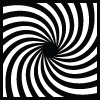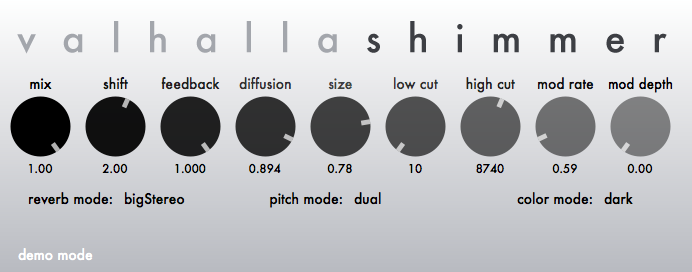Subtotal: $50 USD
Introducing ValhallaShimmer
I am happy to announce my first commercial plugin, ValhallaShimmer:
ValhallaShimmer is an algorithmic reverberation plugin. It is designed to produce BIG sounds, from concert halls, to the Taj Mahal, to the halls of Valhalla.
There are several reverberation modes available, to allow the user to dial in the preferred initial sound. By adjusting the Feedback, Diffusion and Size controls, the attack, sustain and decay of the reverb signal can be fine tuned. The modulation controls can be set to produce subtle mode thickening, glistening string ensemble-esque decays, and the distinctive random modulation of the older Lexicon hall algorithms. Two tone controls and the Color Mode selector allow the timbre to be adjusted from bright and glistening to a more natural dark decay, similar to that produced by air absorption in large spaces.
In addition, ValhallaShimmer has the ability to pitch shift the feedback signal. There are 3 pitch shift modes available:
- Single, where the feedback is shifted up or down by the Shift value.
- Dual, where the feedback is shifted both up and down (in parallel) by the Shift value.
- Bypass, which turns off the pitch shifting (useful for “standard” reverb sounds).
By setting the Shift amount to +12 semitones, and the Feedback to 0.5 or greater, the classic “shimmer” sound is produced, as heard on Eno / Lanois productions for U2 and others. I have discussed the “shimmer” effect in great (excruciating?) detail in earlier blog posts, and applied the research to the architecture of ValhallaShimmer. The resulting algorithms allow for the classic shimmer effects to be generated with ease, as well as a variety of pitch shifted, evolving ambiences.
ValhallaShimmer is the end result of several years of research, and is highly optimized:
- The core pitch shifting algorithm uses randomization to avoid the comb filtering artifacts that can be heard in simpler pitch shifters.
- The code has been optimized for SIMD processors, in order to allow the complex algorithm to run while using a small fraction of modern CPUs.
- The reverberation algorithm has been designed to work in conjunction with the pitch shifting, to allow for high levels of feedback without compromising stability.
- The algorithm works well with cascading multiple instances, both from a signal processing perspective and in terms of the low CPU consumption.
I will be posting more sound examples during the week (earlier examples can be heard here and here). For now, here’s a sound file that showcases the use of ValhallaShimmer for deep ambient sounds. The example uses 4 instances of Shimmer in series, with pitch shifting on 3 of the instances (+/- 12 semitones, +/- 7 semitones, and +/- 5 semitones).
ValhallaShimmer has been released for OSX (AU, VST, RTAS) and Windows (VST). 64-bit Audio Units, 64-bit Windows VST, and Windows RTAS will be coming soon.
 Valhalla Delay
Valhalla Delay 




“Windows plugins (VST/RTAS) to follow shortly thereafter.”
You’re killing me here. 🙂
I know. In all honesty, there are a few issues that need to be figured out on the Windows side – typeface portability, plus using a different vector library. I don’t anticipate that the port will be difficult, as the framework I use is generally cross-platform, but I want to give myself enough time to test things in a variety of hosts.
The Windows version of ValhallaFreqEcho uncovered some bugs in the framework that weren’t supposed to be there (regarding dependencies between VST and RTAS versions of the code), so I want to avoid any issues like that for ValhallaShimmer.
How much will it cost? It seems like a cool effect 🙂
Saw this linked to on Synthtopia.com, really looking forward to the release.
How does “feedback” work with a reverb? Is it roughly similar to the decay time in conventional reverbs?
Nice sounds in any case!
Feedback is usually used in algorithmic reverbs to achieve the desired decay time. A common technique is to have a bank of parallel delay lines coupled with a matrix, or a number of series allpass delay lines (often combined with non-allpass delays in series), that have a certain amount of decay time in and of themselves. By controlling the feedback around the system, the reverb time can be extended, with very long decay times achieved as the feedback gain approaches 1.0.
In the case of ValhallaShimmer, there are several factors that influence the decay time – Diffusion, Feedback, and Size. In many of the algorithms, setting Diffusion to a high value will result in a very long reverb decay. In addition, many of the sounds ValhallaShimmer can obtain have a non-exponential decay, so the standard RT60 calculations aren’t really as useful in such a circumstance.
BTW, what have you been up to lately, Antti? For us DSP geeks, Antti is known for a series of excellent articles on virtual analog synthesis, including high quality nonlinear swept filters like the Moog ladder, and bandlimited synth waveforms.
Diffusion affecting decay time? How do you achieve this?
In all the reverb topologies I’ve studied (parallel combs, FDN with optional allpasses and Dattorro / Griesinger-style allpass loops), the diffusion mainly affects the echo density.
I went back to university and finished my masters degree (iow, passed the mandatory swedish exam at last) and wrote the thesis too: http://lib.tkk.fi/Dipl/2010/urn100219.pdf. The work was done a few years ago originally and ended up in the mp3/ogg/midi playback ICs made by VLSI Solution (http://www.vlsi.fi/en/products.html). Next I should probably get around to finishing the paper on alias free distortion…
As far as diffusion affecting decay time: Go back to the original Schroeder designs. Like 1961. It is also worth noting that the later Quantec designs would have their decay times affected by diffusion. Which gives me a lot of input as to how they do things, but I’ll leave that as an exercise for the reader. 😉
I’ll check out your master’s thesis tomorrow. Your papers were always excellent reads, and I look forward to any new papers you have to write. I’ll also check out the ICs you worked on.
Sounds great! Any info on the price?
Not yet. I’ll announce the price when the plugin is offered for sale, and the demo goes up
the effect demos are great… enjoyed it much
sounds too good 🙂
sean,The Vahalla Shimmer Plugin made my heart skip. I must use this with Thomas Newman , the film composer i have worked with for the last 15 movies.
As soon as i can purchase this, let me know. Great Work!
Hi, I’m not very technical. When you say 4 instances in series, you mean 4 inserts on the same track or mix?
I eagerly await the release of your plugin!
Thx, Pierre
Exactly – 4 inserts on the same track.
Hey there!
Nice thing which is absolutely worth trying out. One thing that strikes me odd when just listening to the examples is that the sound (including the “shimmering”) reminds me of what comes out of NI Reaktor’s Space Master when playing with large room and long decay settings.
Frankly I’ve got no idea how Space Master works and given all the thought and studying you put into this I really wonder if there should be such a similiarity at all?!
It’s been some time since I played with Space Master though, so maybe I should do a full listening comparison.
Shimmer has a few similarities to SpaceMaster, but differs in degree. The basic SpaceMaster algorithm sits somewhere between smallRoom and mediumRoom in complexity, so mediumRoom would have more echo density for a given setting of Size. The mono and bigStereo algorithms are far more complex than SpaceMaster. The modulation is different as well, with SpaceMaster using a multi-phase LFO, while Shimmer has independent LFOs for each building block. Different filtering, different partitioning of the building blocks, different controls, etc.
I always liked SpaceMaster, but it wasn’t much of an influence on the design of Shimmer. Both algorithms have their roots in the early works of both Schroeder and Griesinger. SpaceMaster was clearly designed to run on older computers, so it has a fairly simple design (or, to be precise, a “lower order”). This also helps avoid the artifacts that can happen when you take this architecture and extend it to higher orders. Meanwhile, I’ve embraced these artifacts in the design of Shimmer. I’ve also optimized the heck out of the basic building blocks, which allows me to create the higher order networks without taxing the CPU.
Once I find time I will check Shimmer with vocals. It’s not like I know every software verb out there (especially not the expensive ones), but among the ones I tried the one that best allows spacey and somewhat full sounding verbs on vocals while keeping the words intelligible is Uhbik-A (eventhough some find it too metallic sounding).
Strangely the the other inexpensive reverb that manages to combine those two qualities is the “Vocal” program on the old Behringer Virtualizer Pro.
So I am quite curious how Shimmer finds the balance between lush and mushy.
Valhalla have really done something very rare indeed… the Valhalla “Shimmer” is truly enigmatic, it is perplexing, curious and very very compelling. In a world of ‘me too’ plugins and endless nostalgia driven plugins you have created something seemingly simply but inadvertently versatile… Oh and for us “Eno Heads” out there is does the 1983 “Apollo” thing very well.. 😉
So I tried the demo and went Damn! that’s exactly what Ive trying to get at through so many combinations of delays and echos. Running a Rhodes piano through it and I’m in heaven. Also stacked instances in series for some beautiful tones. Thanks – waiting patiently (alright, a little impatiently just because I want to be interrupt free) for the download link to the full version.
I have an acoustic guitar track (dropped D) playing in my cans as I write this. I’m overjoyed! This is the sound of the ethers, the very sound I’ve always sought after in synths, but never found. It spreads and blossoms from the original signal in a very compelling and musical way. It’s like looking right up int an endless blue sky on a summer afternoon. You can bet I’ll be using this.
Excellent work, thank you.